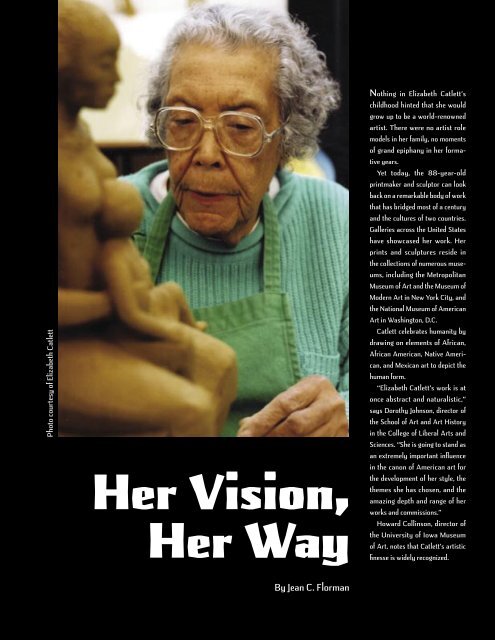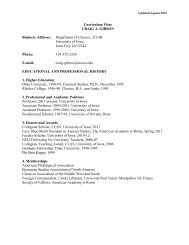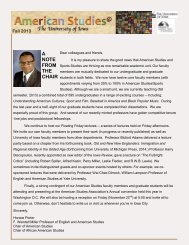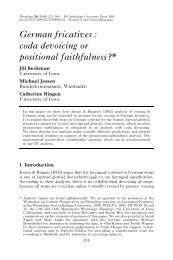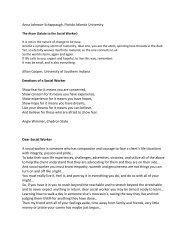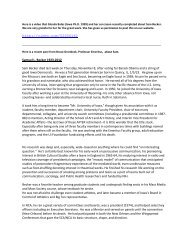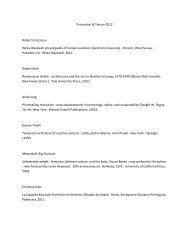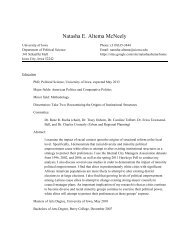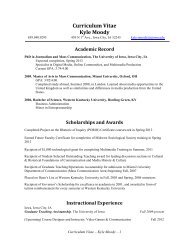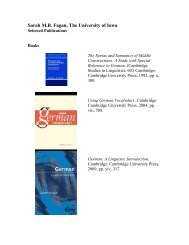By Jean C. Florman - College of Liberal Arts & Sciences - The ...
By Jean C. Florman - College of Liberal Arts & Sciences - The ...
By Jean C. Florman - College of Liberal Arts & Sciences - The ...
Create successful ePaper yourself
Turn your PDF publications into a flip-book with our unique Google optimized e-Paper software.
Photo courtesy <strong>of</strong> Elizabeth Catlett<br />
Her Vision,<br />
Elizabeth Catlett<br />
Her Way<br />
<strong>By</strong> <strong>Jean</strong> <strong>Florman</strong><br />
<strong>By</strong> <strong>Jean</strong> C. <strong>Florman</strong><br />
Nothing in Elizabeth Catlett’s<br />
childhood hinted that she would<br />
grow up to be a world-renowned<br />
artist. <strong>The</strong>re were no artist role<br />
models in her family, no moments<br />
<strong>of</strong> grand epiphany in her formative<br />
years.<br />
Yet today, the 88-year-old<br />
printmaker and sculptor can look<br />
back on a remarkable body <strong>of</strong> work<br />
that has bridged most <strong>of</strong> a century<br />
and the cultures <strong>of</strong> two countries.<br />
Galleries across the United States<br />
have showcased her work. Her<br />
prints and sculptures reside in<br />
the collections <strong>of</strong> numerous museums,<br />
including the Metropolitan<br />
Museum <strong>of</strong> Art and the Museum <strong>of</strong><br />
Modern Art in New York City, and<br />
the National Museum <strong>of</strong> American<br />
Art in Washington, D.C.<br />
Catlett celebrates humanity by<br />
drawing on elements <strong>of</strong> African,<br />
African American, Native American,<br />
and Mexican art to depict the<br />
human form.<br />
“Elizabeth Catlett’s work is at<br />
once abstract and naturalistic,”<br />
says Dorothy Johnson, director <strong>of</strong><br />
the School <strong>of</strong> Art and Art History<br />
in the <strong>College</strong> <strong>of</strong> <strong>Liberal</strong> <strong>Arts</strong> and<br />
<strong>Sciences</strong>. “She is going to stand as<br />
an extremely important influence<br />
in the canon <strong>of</strong> American art for<br />
the development <strong>of</strong> her style, the<br />
themes she has chosen, and the<br />
amazing depth and range <strong>of</strong> her<br />
works and commissions.”<br />
Howard Collinson, director <strong>of</strong><br />
the University <strong>of</strong> Iowa Museum<br />
<strong>of</strong> Art, notes that Catlett’s artistic<br />
finesse is widely recognized.<br />
<strong>The</strong> University <strong>of</strong> Iowa 7
8 <strong>Arts</strong> & <strong>Sciences</strong><br />
“All <strong>of</strong> Catlett’s works—whether 18 inches<br />
or four feet tall—are magnificently crafted. She<br />
pays particular attention to surfaces, and even<br />
the bronzes have a beautiful texture.”<br />
Catlett was born in 1915. Her father, who had<br />
taught mathematics at Tuskeegee University,<br />
succumbed to tuberculosis shortly before Elizabeth<br />
was born. Left with three children to support,<br />
Elizabeth’s mother became a truant <strong>of</strong>ficer<br />
in Washington, D.C. She taught her children to<br />
follow their dreams by becoming educated, a<br />
lesson she had learned from her own parents.<br />
“Education was very important to my mother’s<br />
parents, who had been slaves,” Catlett<br />
says. “After the Civil War, they made sure that<br />
all four <strong>of</strong> their sons graduated from university<br />
and all four <strong>of</strong> their daughters graduated from<br />
seminary school.”<br />
Catlett followed suit. In 1935 she graduated<br />
cum laude from Howard University with<br />
a B.S. degree in printmaking, drawing, and art<br />
history. She then became an educator herself,<br />
teaching art in a North Carolina high school for<br />
two years.<br />
<strong>By</strong> 1938 she had decided to continue her<br />
formal training at an artistic mecca in the Midwest.<br />
At <strong>The</strong> University <strong>of</strong> Iowa, she studied<br />
with sculptor Henry Stinson and regionalist<br />
painter Grant Wood.<br />
“Grant Wood was a very generous teacher,”<br />
Catlett says, “and he influenced all my work.<br />
He would tell his students, ‘Paint what you<br />
know.’ ”<br />
For Catlett, that mostly meant black women.<br />
<strong>The</strong> mother-child bond, a recurring motif in her<br />
work, was inspired by the strong bond with her<br />
own mother and grandmothers.<br />
“For Grant Wood’s class, I painted a young<br />
girl ironing,” Catlett recalls. “My grandmother<br />
taught me to iron. First I started with overalls,<br />
then overall shirts. <strong>The</strong>n I finally graduated to<br />
dress shirts. I’m a good ironer, so that’s what<br />
I painted.”<br />
While at Iowa, Catlett spent many 11-hour<br />
days and weekends in the school’s art studios.<br />
Her $35-per-month budgeted expenses<br />
included $10 rent for a room in a local home.<br />
At the time, African American students were<br />
not allowed to live in University residence<br />
halls, so the young artist roomed in the home<br />
<strong>of</strong> a Mrs. Scott.<br />
Catlett says that because she had grown<br />
up in Washington, D.C., a city divided by clear<br />
and unyielding race lines, Iowa’s combination<br />
<strong>of</strong> openness and segregation<br />
surprised her.<br />
“I’d lived in an African<br />
American culture my whole<br />
life,” she says. “In Iowa City, I<br />
suddenly was living among white<br />
people, but I still couldn’t do things<br />
like live in the dorms.”<br />
Although Catlett excelled in her course<br />
work, the University almost didn’t award<br />
her a degree. Near the end <strong>of</strong> her final<br />
semester, she was told that she could not<br />
receive an M.F.A. because she had not taken<br />
printmaking.<br />
“<strong>The</strong> head <strong>of</strong> the department apparently<br />
was unhappy because I had taken a bronze<br />
foundry course at the <strong>College</strong> <strong>of</strong> Engineering<br />
instead <strong>of</strong> printmaking,” she says. “I had<br />
taken the engineering course to learn about<br />
lost wax and sand casting.”<br />
At the time, the school’s art gallery<br />
was displaying Catlett’s graduate work,<br />
including stone carvings, cast cement<br />
nudes, a fresco painting, terra-cotta<br />
masks, and a bronze mask—one <strong>of</strong><br />
the three pieces she created during<br />
the engineering course. Catlett says<br />
the issue still hadn’t been settled<br />
by the day <strong>of</strong> her thesis defense,<br />
and at the end <strong>of</strong> her defense,<br />
her committee sent her out <strong>of</strong><br />
the room.<br />
“I waited for the longest<br />
time,” she says. “Finally, Grant<br />
Wood came out and said, ‘Congratulations.<br />
You have earned<br />
your degree.’ ”
Catlett and two other students earned the<br />
first M.F.A. degrees awarded by the University.<br />
Her graduate thesis project, a stone carving <strong>of</strong><br />
a black mother and child, earned first prize in<br />
Chicago’s 1940 American Negro Exposition<br />
and then graced the University campus for<br />
many years.<br />
Following graduation, Catlett taught at several<br />
schools, including Dillard University in<br />
New Orleans, where she became head <strong>of</strong> the<br />
art department. During a summer spent learning<br />
ceramic techniques at the Art Institute <strong>of</strong><br />
Chicago, she met and married her first husband,<br />
artist Charles White. In 1944 the couple<br />
moved to New York City, where she served<br />
two years as a fund-raiser and teacher at the<br />
George Washington Carver School in Harlem.<br />
“<strong>The</strong> people who came to the school worked<br />
all day as laundresses, elevator operators, and<br />
domestics, and then went to class from seven<br />
to ten at night,” Catlett says. “We charged<br />
three dollars a course, and most <strong>of</strong> the teachers<br />
were volunteers.<br />
“I discovered that these were the people<br />
I wanted to create art for,” she adds. “<strong>The</strong>se<br />
were humble, hardworking, intelligent people,<br />
hungry for culture and for education. <strong>The</strong>y<br />
embraced everything—authors who came to<br />
visit the school, musicians from Juilliard, art at<br />
the Metropolitan.”<br />
During her tenure at the Carver School,<br />
Catlett continued to mature as an artist. Russian<br />
sculptor Ossip Zadkine, who was living in<br />
New York, became her mentor. Her work was<br />
exhibited in the New Orleans Museum <strong>of</strong> Art<br />
and the Modern Art Museum <strong>of</strong> Mexico, and in<br />
1945 she won the first <strong>of</strong> two grants from the<br />
Julius Rosenwald Foundation. Catlett used the<br />
grants to study public art in Mexico City.<br />
Years before, a brief stint with the<br />
Depression-era Public Works Administration<br />
had sparked Catlett’s fascination with public<br />
art. As a sophomore at Howard University,<br />
she had been employed briefly by the PWA<br />
as a muralist.<br />
“I was supposed to paint a mural for the<br />
dome <strong>of</strong> a local teacher’s college,” she recalls,<br />
“but I had never seen a mural, and didn’t know<br />
what one was supposed to look like. So I went<br />
to school all week, worked on Friday nights,<br />
and then spent Saturdays in the Congressional<br />
Library looking up everything I could<br />
find about murals. I became fascinated by the<br />
murals <strong>of</strong> Diego Rivera, but never really understood<br />
how I was supposed to actually create a<br />
two-foot-high painting around a circular dome.<br />
After five weeks, I was fired.”<br />
Nevertheless, Catlett says, the experience<br />
gave her two things: a love <strong>of</strong> large-scale public<br />
art and an understanding that opportunities<br />
should be seized. Both helped ease her into the<br />
heady art world <strong>of</strong> mid-century Mexico, where<br />
she moved in 1946. Catlett quickly became<br />
part <strong>of</strong> the vibrant inner circle <strong>of</strong> Latin American<br />
Social Realists that included Rivera, Frida<br />
Kahlo, David Alfaro Siquerios, and painter<br />
Francisco Mora. When Catlett and Mora fell<br />
in love, she divorced her first husband. Mora<br />
died in 2002, but the couple enjoyed 56 years<br />
<strong>of</strong> marriage strengthened by shared artistic<br />
ambitions, political passions, and parenthood.<br />
In Mexico, Catlett found an environment<br />
that welcomed and nurtured artists. She was<br />
appointed the first woman to head the sculpture<br />
department at the National School <strong>of</strong><br />
Fine <strong>Arts</strong>, in Mexico City, a position she held<br />
from 1959 until 1976. Because she wanted<br />
to exercise her political rights in her adopted<br />
home, Catlett became a citizen <strong>of</strong> Mexico in<br />
1962. Today she divides her time between her<br />
Cuernavaca home outside Mexico City and an<br />
apartment in New York City.<br />
In 1996 <strong>The</strong> University <strong>of</strong> Iowa awarded<br />
Catlett the Distinguished Alumni Award.<br />
Iowa’s Museum <strong>of</strong> Art owns a Catlett linocut,<br />
“Sharecropper (Cosechadora de algodon),”<br />
and the University has commissioned a sixfoot-high<br />
bronze statue for display on campus.<br />
Above: “Sharecropper,” 1968, linocut, 25 9/16 x 19 12/16 inches,<br />
University <strong>of</strong> Iowa Museum <strong>of</strong> Art, purchased by the friends <strong>of</strong><br />
<strong>Jean</strong> Davidson<br />
Left: “Stepping Out,” 2000, bronze, 30 inches, courtesy <strong>of</strong> June<br />
Kelly Gallery, New York City<br />
Recently the artist won a competition to<br />
honor African American writer Ralph Ellison.<br />
Her 15-foot bronze will be installed in<br />
New York City near the apartment where the<br />
author’s widow still lives. Catlett also has been<br />
commissioned to create three pieces honoring<br />
civil rights activist Mary Church Terrell.<br />
“When I went to Washington, D.C., to chat<br />
about the work,” Catlett says, “I walked into<br />
the meeting room and there were 15 people<br />
sitting there telling me where the sculpture<br />
was going to go, what it should look like, what<br />
materials I should use. I let it go on for a while,<br />
and then I said, ‘I’m not listening to you.’ <strong>The</strong>y<br />
were very surprised.”<br />
<strong>The</strong>re is no doubt Catlett is an artist to be<br />
reckoned with. She continues to work every<br />
day except Sunday, and until two years ago,<br />
she still wielded a chain saw to rough out her<br />
wood sculptures. Her humanism and compassion<br />
for the ordinary individual suffuse every<br />
curved arm cradling a child and sharp chin<br />
tilted upward in grace and defiance. <strong>By</strong> following<br />
Grant Wood’s gentle advice to “depict<br />
what you know,” Catlett has used the language<br />
<strong>of</strong> her own heritage and experience to speak to<br />
the world.<br />
<strong>The</strong> University <strong>of</strong> Iowa 9


